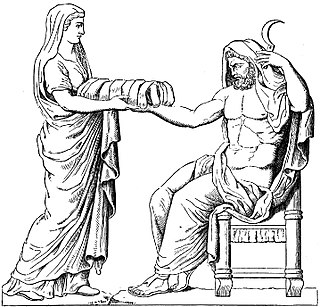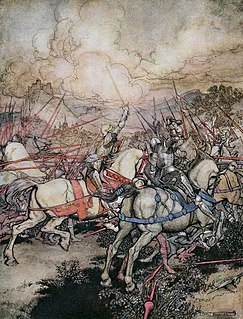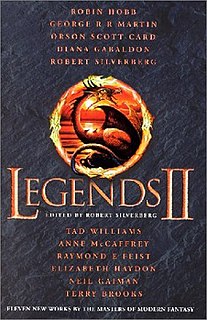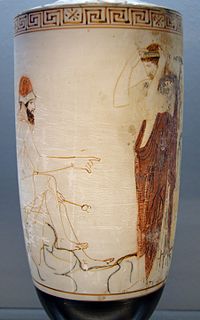
In ancient Greek religion and mythology, Demeter is the Olympian goddess of the harvest and agriculture, presiding over grains and the fertility of the earth. She is also called Deo (Δηώ).

Hades, in the ancient Greek religion and myth, is the god of the dead and the king of the underworld, with which his name became synonymous. Hades was the eldest son of Cronus and Rhea, although this also made him the last son to be regurgitated by his father. He and his brothers, Zeus and Poseidon, defeated their father's generation of gods, the Titans, and claimed rulership over the cosmos. Hades received the underworld, Zeus the sky, and Poseidon the sea, with the solid earth, long the province of Gaia, available to all three concurrently. In artistic depictions, Hades is typically portrayed holding a bident and wearing his helm with Cerberus, the three-headed guard dog of the underworld, standing to his side.

In Greek mythology, Persephone, also called Kore or Kora, is the daughter of Zeus and Demeter. She became the queen of the Underworld after her abduction by Hades, the god of the underworld, with the approval of her father and brother-in-law, Zeus. The myth of her abduction, her sojourn in the underworld and her temporary return to the surface represents her functions as the embodiment of spring and the personification of vegetation, especially grain crops, which disappear into the earth when sown, sprout from the earth in spring, and are harvested when fully grown. In Classical Greek art, Persephone is invariably portrayed robed, often carrying a sheaf of grain. She may appear as a mystical divinity with a sceptre and a little box, but she was mostly represented in the process of being carried off by Hades.

Rhea or Rheia is a goddess in Greek mythology, the Titaness daughter of the earth goddess Gaia and the sky god Uranus, Gaia's son. She is the older sister of Cronus, who was also her consort. In early traditions, she is known as "the mother of gods" and therefore is strongly associated with Gaia and Cybele, who have similar functions. The classical Greeks saw her as the mother of the Olympian gods and goddesses. The Romans identified her with Magna Mater, and the Goddess Ops.

Dionysus is the god of the grape-harvest, winemaking, orchards and fruit, vegetation, fertility, insanity, ritual madness, religious ecstasy, festivity and theatre in ancient Greek religion and myth. He is also known as Bacchus, the name adopted by the Romans; the frenzy that he induces is bakkheia. As Eleutherios, his wine, music and ecstatic dance free his followers from self-conscious fear and care, and subvert the oppressive restraints of the powerful. His thyrsus, a fennel-stem sceptre, sometimes wound with ivy and dripping with honey, is both a beneficent wand and a weapon used to destroy those who oppose his cult and the freedoms he represents. Those who partake of his mysteries are believed to become possessed and empowered by the god himself.

In ancient Greek religion and mythology, the Moirai, often known in English as the Fates, were the incarnations of destiny; their Roman equivalent was the Parcae, and there are other equivalents in cultures that descend from the Proto-Indo-European culture. Their number became fixed at three: Clotho ("spinner"), Lachesis ("allotter") and Atropos.

In Greek mythology, Iris is a daughter of the gods Thaumas and Electra, the personification and goddess of the rainbow and messenger of the gods.

In the Aztec religion, Huitzilopochtli is a deity of war, sun, human sacrifice, and the patron of the city of Tenochtitlan. He was also the tribal god of the Mexicas, also known as Aztecs, of Tenochtitlan. Many in the pantheon of deities of the Aztecs were inclined to have a fondness for a particular aspect of warfare. However, Huitzilopochtli was known as the primary god of war in ancient Mexico. Since he was the patron god of the Mexica, he was credited with both the victories and defeats that the Mexica people had on the battlefield. The people had to make sacrifices to him to protect the Aztec from infinite night. He wielded Xiuhcoatl, the fire serpent, as a weapon, thus also associating Huitzilopochtli with fire.

Historical fantasy is a category of fantasy and genre of historical fiction that incorporates fantastic elements into a more "realistic" narrative. There is much crossover with other subgenres of fantasy; those classed as Arthurian, Celtic, or Dark Ages could just as easily be placed in historical fantasy. Stories fitting this classification generally take place prior to the 20th century.

Legends II: New Short Novels by the Masters of Modern Fantasy is a 2003 collection of 11 short stories by a number of fantasy authors, edited by Robert Silverberg. All the stories were original to the collection, and set in the authors' established fictional worlds. The first Legends was published in 1998.

"The Frost-Giant's Daughter" is one of the original fantasy short stories about Conan the Cimmerian, written by American author Robert E. Howard.
The Norse mythology, preserved in such ancient Icelandic texts as the Poetic Edda, the Prose Edda, and other lays and sagas, was little known outside Scandinavia until the 19th century. With the widespread publication of Norse myths and legends at this time, references to the Norse gods and heroes spread into European literary culture, especially in Scandinavia, Germany, and Britain. In the later 20th century, references to Norse mythology became common in science fiction and fantasy literature, role-playing games, and eventually other cultural products such as Japanese animation. Storytelling was an important aspect of Norse mythology and centuries later, with the rediscovery of the myth, Norse mythology once again relies on the impacts of storytelling to spread its agenda.

In mythology, the Greek underworld is an otherworld where souls go after death. The original Greek idea of afterlife is that, at the moment of death, the soul is separated from the corpse, taking on the shape of the former person, and is transported to the entrance of the underworld. Good people and bad people would then separate. The underworld itself—referred to as Hades, after its patron god—is described as being either at the outer bounds of the ocean or beneath the depths or ends of the earth. It is considered the dark counterpart to the brightness of Mount Olympus with the kingdom of the dead corresponding to the kingdom of the gods. The underworld is a realm invisible to the living, made solely for the dead.

In Greek mythology, Despoina was the daughter of Demeter and Poseidon and sister of Arion.
Mythic Warriors is a 1998-2000 animated television series, which featured retellings of popular Greek myths that were altered so as to be appropriate for younger audiences, produced by Nelvana and Marathon Media. Two seasons of episodes were produced in 1998 and 1999; then aired as reruns until 2000, when CBS' abolition of its children's programming resulted in its cancellation. The series was based on the book series Myth Men Guardians of the Legend written in 1996 and 1997 by Laura Geringer and illustrated by Peter Bollinger.
In Greek mythology, Arion or Areion, is a divinely-bred, fabulously fast, black-maned horse. He saved the life of Adrastus, king of Argos, during the war of the Seven against Thebes.
Myth is a folklore genre consisting of narratives that play a fundamental role in a society, such as foundational tales or origin myths. The main characters in myths are usually non-humans, such as gods, demigods, and other supernatural figures. However, others also include humans, animals, or combinations in their classification of myth. Stories of everyday human beings, although often of leaders of some type, are usually contained in legends, as opposed to myths. Myths are sometimes distinguished from legends in that myths deal with gods, usually have no historical basis, and are set in a world of the remote past, very different from that of the present.

Michael J. Sullivan is a New York Times, USA Today, and Washington Post bestselling American writer of epic fantasy and science fiction, best known for his debut series The Riyria Revelations, which has been translated into fourteen languages. In 2012 io9 named him one of the "Most Successful Self-Published Sci-Fi and Fantasy Authors". His books have been translated into French, German, Spanish, Czech, Dutch, Polish, Hungarian, Japanese, Georgian, Bulgarian, Russian, Portuguese, Italian and Turkish.
In Greek mythology, Soter was the personification or daimon of safety, preservation and deliverance from harm.














